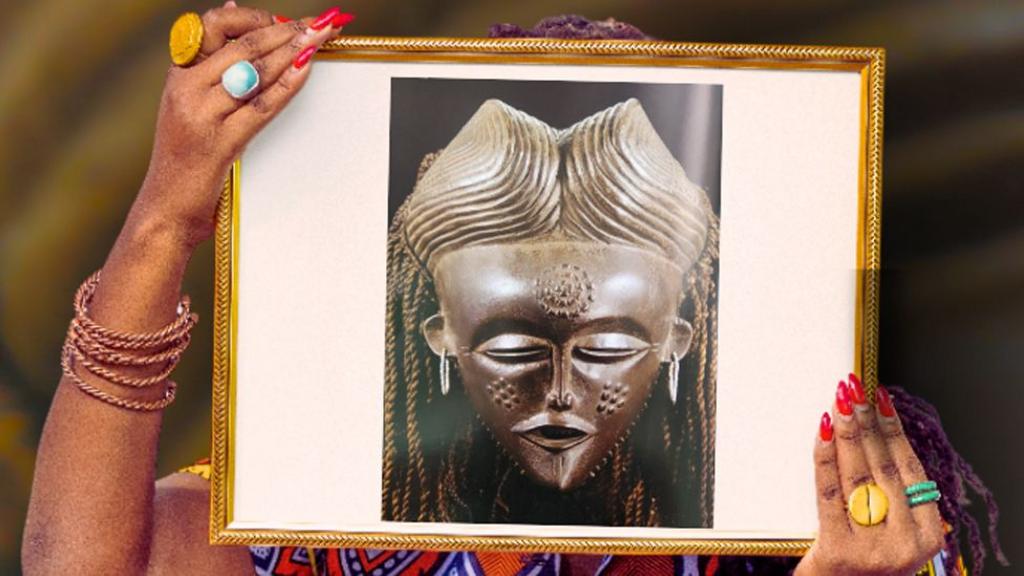A Zambian hunter’s toolbox, inscribed with an ancient writing system, has recently garnered significant attention on social media.
“We’ve been taught that Africans were illiterate,” states Samba Yonga, co-founder of the virtual Women’s History Museum of Zambia.
“However, we possessed our own sophisticated writing systems and knowledge transmission methods, largely ignored and marginalized,” she explains to the BBC.
This artifact spearheaded an online campaign to illuminate women’s roles in pre-colonial Zambia and revive cultural legacies nearly eradicated by colonialism.
Another remarkable piece is an intricately adorned leather cloak, unseen in Zambia for over a century.
“These artifacts represent a crucial, yet largely unknown history,” Yonga emphasizes.
“Colonialism disrupted and obscured our relationship with our cultural heritage.
“The deliberate erasure of women’s roles is particularly shocking.”
Yet, Yonga notes, “a resurgence of interest in connecting with and reclaiming our cultural heritage is underway—through fashion, music, and academic pursuits.”
“We had our own expressions of love and beauty,” she asserts. “We had sustainable practices for health and environmental stewardship. We enjoyed prosperity, unity, respect, and intellectual achievement.”
Fifty artifacts have been showcased on social media, accompanied by details illustrating women’s central roles in societal belief systems and ecological understanding.
The artifacts’ images are presented within frames, highlighting how presentation influences perception—mirroring how British colonialism distorted Zambian history through the suppression and destruction of indigenous knowledge.
The “Frame” project actively challenges the persistent misconception that African societies lacked indigenous knowledge systems.
Most of these artifacts were collected during the colonial era and stored in museums worldwide, including Sweden—where this social media initiative originated in 2019.
During a visit to Stockholm, Yonga met Michael Barrett, a curator at the Swedish National Museums of World Cultures.
Upon learning of Yonga’s Zambian heritage, Barrett revealed the museum’s extensive Zambian artifact collection.
“It was astonishing,” Yonga recalls, “prompting the question: ‘How could a nation without a colonial history in Zambia possess such a vast Zambian collection?'”
During the 19th and early 20th centuries, Swedish explorers, ethnographers, and botanists traveled to Zambia via British ships and overland routes.
The museum holds nearly 650 Zambian cultural objects and roughly 300 historical photographs, collected over a century.
Yonga and co-founder Mulenga Kapwepwe were surprised to discover that the Swedish collectors had reached even remote areas of Zambia.
The collection includes fishing baskets, ceremonial masks, pottery, a cowry shell belt, and 20 remarkably well-preserved leather cloaks from a 1911-1912 expedition.
Crafted from lechwe antelope hides by Batwa men, these cloaks were worn by women or used to protect infants.
Yonga describes the cloaks’ exterior as featuring “meticulously designed geometric patterns.”
Photographs depict women wearing the cloaks, complemented by ethnographer Eric Van Rosen’s 300-page notebook, with detailed illustrations and photographs.
“He meticulously documented the cloaks’ design, construction, tools, geographic origin, and the women who wore them.”
The Swedish museum had not researched the cloaks, and the Zambian National Museums Board was unaware of their existence.
Yonga and Kapwepwe sought further information from the Bengweulu region community, the cloaks’ origin.
“Local memory of their creation had vanished,” Yonga explains. “Those who held this knowledge were gone, leaving these cloaks frozen in time within that Swedish museum.”
One of Yonga’s favorites in the project is Sona (or Tusona), a sophisticated, rarely-used writing system.
Used by the Chokwe, Luchazi, and Luvale people across Angola, the Democratic Republic of Congo, and northwestern Zambia, geometric patterns were created on sand, cloth, bodies, furniture, and hunting tools.
These patterns convey mathematical principles, cosmological references, environmental messages, and societal guidelines.
Sona’s original custodians and teachers were women, and some elders still retain knowledge of the system.
These elders are invaluable resources for Yonga’s research, corroborating work by scholars like Marcus Matthe and Paulus Gerdes.
“Sona has been incredibly popular on social media, generating surprise and excitement—reactions of ‘What? How is this possible?'”
The “Queens in Code: Symbols of Women’s Power” post features a Tonga woman from southern Zambia with a mealie grinder.
The Women’s History Museum of Zambia discovered that this stone grinder was not merely a kitchen tool.
It belonged solely to its user and was placed on her grave as a tombstone, signifying her contribution to food security.
“This grinding stone is, in fact, a symbol of women’s power,” Yonga explains.
Established in 2016, the Women’s History Museum of Zambia documents and archives women’s histories and indigenous knowledge.
It conducts community research and creates an online archive of Zambian artifacts held abroad.
“We’re piecing together a puzzle with missing parts—it’s a treasure hunt.”
This treasure hunt has profoundly impacted Yonga, and she hopes the “Frame” project will similarly affect others.
“Understanding my community’s history, politically, socially, and emotionally, has reshaped my global perspective.”
Penny Dale is a freelance journalist, podcast and documentary-maker based in London
Go to BBCAfrica.com for more news from the African continent.
Follow us on Twitter @BBCAfrica, on Facebook at BBC Africa or on Instagram at bbcafrica
Kigali accuses the central African organisation ECCAS of pandering to the demands of Kinshasa.
Military police are investigating the alleged incident near the British army’s training camp in Kenya.
Olly Stephens’ friend Demi hopes her podcast will raise awareness of online harm.
The blaze broke out a day after protests over plans to oust former speaker Jonathan Fonati Koffa.
Why models from South Sudan, a lush but troubled nation, are sought after by the big fashion brands.

